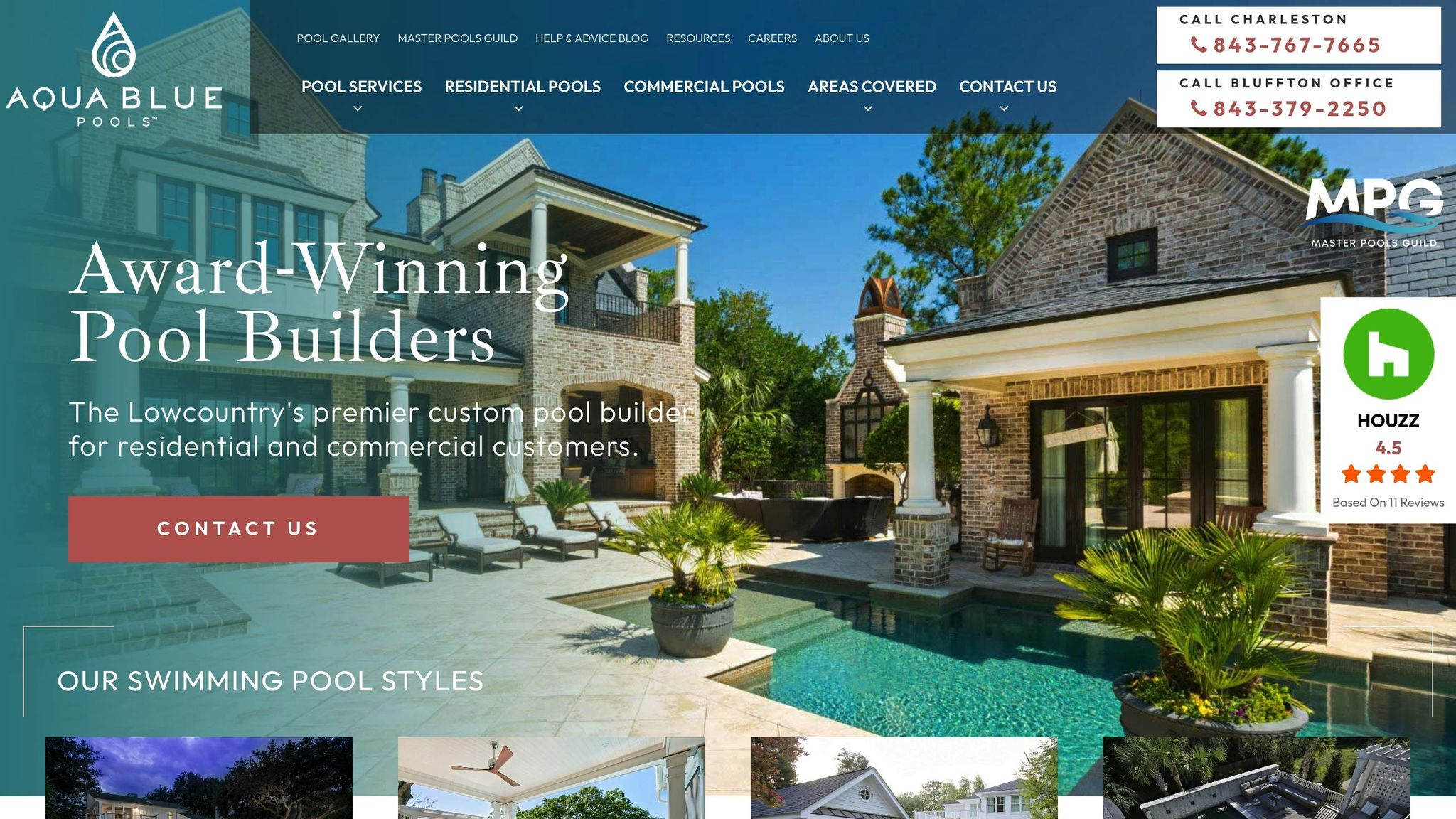When deciding between pool renovation and new construction, the choice comes down to cost, goals, and the pool’s condition. Renovation typically costs less upfront, ranging from $5,000 to $50,000+, and works well for cosmetic or functional upgrades. New construction, starting around $30,000 and exceeding $500,000+, is ideal for major structural issues or when full customization is desired.
Key Points:
- Renovation is faster (1–8 weeks) and cost-effective for updates like resurfacing or replacing tiles.
- New construction offers complete design freedom but takes longer (8–12 weeks or more) and requires a larger investment.
- Renovation works best if the pool structure is sound; new construction is better for severe damage or outdated systems.
Quick Comparison
| Factor | Pool Renovation | New Pool Construction |
|---|---|---|
| Cost | $5,000 – $50,000+ | $30,000 – $500,000+ |
| Timeline | 1–8 weeks | 8–12 weeks (or longer) |
| Customization | Limited to existing pool | Fully customizable |
| Best For | Cosmetic upgrades | Structural issues, modern designs |
Tip: Renovate if your pool is in good shape but needs updates. Build new if you’re aiming for a custom design or fixing major issues.
Swimming Pool Renovation and New Pool Construction
Pool Renovation Costs
Now that we’ve covered what pool renovation involves, let’s dive into the costs. Renovation expenses can vary widely based on the type of work and materials involved. Knowing these costs can help you plan your budget and prioritize the upgrades that make the most sense for your pool.
Average Renovation Costs
The average cost of a pool renovation is $10,112, with most projects falling between $5,369 and $14,871. However, costs can range anywhere from $1,600 to $29,000, depending on the scope of the work.
For above-ground pools, renovations typically cost between $500 and $3,000. On the other hand, remodeling an in-ground pool can range from $6,000 to $30,000. This broad range reflects the variety of options available, from simple updates to complete overhauls.
| Renovation Type | Average Cost |
|---|---|
| Vinyl Liner Replacement | $2,000 |
| Tile Resurfacing | $2,000 |
| Ceramic Tile Replacement | $3,000 |
| Glass Tile Replacement | $3,500 |
| Pool Deck Resurfacing | $3,000 |
| Pool Skimmer Replacement | $3,000 |
| Pool Step Repair/Replacement | $4,500 |
| Pool Deck Construction | $7,500 |
| Concrete Patio Construction | $10,500 |
Larger projects, like resurfacing, can cost between $6,000 and $15,000. If you’re considering reshaping your pool, expect to spend anywhere from $50,000 to $100,000. On the simpler side, tasks like replacing a vinyl liner or retiling average around $3,000 and can make a big difference in your pool’s look.
What Affects Renovation Costs
Several factors influence how much you’ll spend on a pool renovation. Materials alone account for about 55% of the cost, with labor making up the remaining 45%. This is why your choice of materials has such a significant impact on the final price.
The size of your pool is a major factor, as many projects are priced by square foot or linear foot. For instance, replacing pool coping can cost $30–$50 per linear foot, while re-grouting averages $3 per square foot.
Material selection also plays a big role. Glass tile replacement, for example, costs about $3,500, compared to $3,000 for ceramic tiles. Concrete resurfacing starts at $5,000, with higher-end finishes raising the price.
The scope of the project matters too. Adding features like pool lights can cost between $450 and $1,700, while converting to a saltwater system ranges from $500 to $2,500. Reshaping your pool is one of the priciest options, starting at $30,000 for vinyl pools and $60,000 for concrete pools.
The condition of your pool’s existing systems also affects costs. For example, upgrading pumps or filters typically costs between $500 and $1,500. If plumbing or structural repairs are needed, those expenses will add up as well.
These factors can help you decide what kind of renovation best fits your needs and budget.
When to Choose Renovation
Renovation is a smart choice when your pool’s structure is in good shape but needs a refresh. It’s a cost-effective way to modernize your pool and can even increase your home’s value by up to 8%.
If you’re looking to upgrade without altering the basic layout, renovations can transform a standard pool into a more luxurious retreat. Adding features like upgraded lighting, water elements, or premium finishes can make a big impact. For instance, you could incorporate modern trends like the clean lines of geometric pools or the dramatic effect of infinity pools.
Renovations can also be tailored to specific styles, whether you’re drawn to the compact elegance of plunge pools or the striking design of elevated pools. This flexibility lets you create a space that reflects your personal taste while enhancing your outdoor living area.
New Pool Construction Costs
Building a pool from the ground up involves a significant upfront investment, but it also offers the freedom to design a pool that fits your vision perfectly. Understanding these costs can help you budget wisely and create the pool of your dreams. Let’s dive into the details of these costs, the factors that influence them, and when starting fresh is the best option.
Average Construction Costs
The cost of building a new pool can vary widely depending on the materials, size, and features you choose. Basic inground pools start at around $30,000. Here’s a breakdown of typical costs by pool type:
- Fiberglass pools: $21,528 to $77,740
- Vinyl liner pools: $29,900 to $53,820
- Concrete pools: Starting at $60,000, often exceeding $100,000.
If you’re considering specialty designs, the price goes up. For example:
- Lap pools: $23,920 to $83,720
- Lagoon-style pools: $59,800 to $119,600
- Plunge pools: $17,342 to $29,302.
For luxury pools, expect to spend even more. These high-end options typically range from $50,000 to $100,000, but in major markets like Los Angeles, custom inground pools can cost between $120,000 and $160,000. Elaborate outdoor spaces with pools may require budgets of $400,000 or more.
Regional pricing also matters. In Northern California, pool construction costs range from $100,000 to over $500,000. Meanwhile, in the Inland Empire, luxury pools are priced between $70,000 and $300,000. In San Diego, costs typically fall between $100,000 and $450,000.
What Affects Construction Costs
Several factors determine the final cost of a new pool. Labor alone can make up 25% to 50% of the total expense. Simple rectangular pools are generally the most affordable, while custom shapes add complexity and cost.
The choice of materials also plays a big role. Concrete pools are known for their durability but come at a higher price. On the other hand, vinyl pools are less expensive initially, though they may require replacements over time.
Size and depth directly influence costs, as larger pools require more materials and labor. For example, a 400-square-foot gunite pool might start at $60,000, with base models often costing closer to $85,000. Custom features can quickly raise the price. Adding water features, for instance, costs an extra $5,000 to $10,000. Rock waterfalls range from $2,500 to $25,000, while diving boards or slides can cost anywhere from $2,000 to $20,000.
Location is another key factor. Real estate values, terrain challenges, and local labor rates all impact costs. For example, difficult terrains or limited access to the construction site can increase equipment and labor expenses.
When to Choose New Construction
Opting for new construction is the way to go when you want full control over your pool’s design, placement, and features. It’s ideal for properties without an existing pool or when the current pool has significant structural problems.
The biggest advantage of new construction is customization. You can tailor every detail to your preferences, from the shape and placement to the features that best suit your property. Whether you’re dreaming of a geometric pool, an infinity pool, or a plunge pool, the possibilities are endless.
New construction also allows you to incorporate energy-efficient equipment, smart automation, and durable materials right from the start. If you’re planning a complete outdoor living space, you can design your pool to complement patios, landscaping, and other elements. Features like elevated pools or luxury pools can create a stunning focal point for your backyard.
While the initial costs are higher, the payoff is a pool perfectly tailored to your lifestyle and long-term goals – free from the compromises that come with renovating an existing pool. New construction is the best choice when you’re looking for a personalized, lasting investment that enhances your property.
sbb-itb-87baa56
Renovation vs New Construction: Side-by-Side Comparison
If you’re weighing the choice between renovating an existing pool or building a brand-new one, it’s essential to consider both the financial and practical aspects. Here’s a breakdown to help you decide which option aligns better with your goals.
Cost and Timeline Comparison Table
To simplify the decision-making process, the table below highlights the primary differences between pool renovation and new construction. While renovation timelines are typically shorter, new construction can take longer, especially for concrete pools, which require 3–6 months for curing.
| Factor | Pool Renovation | New Pool Construction |
|---|---|---|
| Initial Cost | $5,000 – $50,000+ | $30,000 – $500,000+ |
| Timeline | 1–8 weeks | 8–12 weeks (3–6 months for concrete pools) |
| Customization | Limited by existing structure | Complete design freedom |
| Resurfacing | $5,000 – $10,000 | Included in construction |
| Tile Replacement | $1,000 – $3,000 | Included in construction |
| Equipment Upgrades | $1,500 – $5,000 | Included in construction |
| Water Features | $3,000 – $10,000 | Included in construction |
| Long-term Value | Moderate property value increase | Significant property value increase |
Now, let’s explore when each option might be the better choice.
When Renovation Costs Less
Renovation works best when your pool’s structure is in good condition and only needs cosmetic or functional updates. For example, resurfacing, replacing tiles, or upgrading equipment can breathe new life into an older pool without the expense of starting from scratch. By reusing existing materials and plumbing systems, you can save a considerable amount of money. Plus, renovations can often be completed in as little as one to two weeks, offering a quick turnaround for noticeable results.
When New Construction Costs Less
On the other hand, new construction becomes the smarter option if your pool has major structural issues, such as foundation damage or extensive plumbing problems. Starting fresh allows you to design a pool tailored to your exact needs and preferences. Whether it’s a luxury pool, an infinity pool, a geometric pool, or an elevated pool, the possibilities are endless. While the upfront cost is higher, new construction provides decades of enjoyment and significantly enhances your property value, making it a worthwhile investment.
Other Important Factors
Cost is a big part of deciding whether to renovate your pool or start fresh with a new one. But there are other key factors to consider that can shape your choice. Taking these into account will help ensure your pool fits your needs for years to come.
Existing Pool Condition and Age
The condition of your current pool is one of the most important things to evaluate. Its age and structural soundness play a major role in whether renovation is a practical option or if starting over makes more sense.
If the pool’s structure is solid, renovation can be a smart move. Issues like faded finishes, outdated tiles, or worn-out equipment can be fixed without touching the foundation, giving you a refreshed pool without a full rebuild.
"If your pool is structurally sound but shows signs of wear – such as surface cracks, discoloration, or outdated features – a renovation may be best. However, significant structural damage like foundation cracks, persistent leaks, or failing filtration systems signals that new construction could be more cost-effective."
Older pools with aging materials and systems often show more wear and tear, which can make renovation less practical. For example, if your pool requires major plumbing or electrical repairs, or if the concrete is severely damaged, replacing it might actually save you money in the long run. When renovation costs start creeping close to the price of building a new pool, it’s usually better to start fresh.
Once you’ve assessed your pool’s condition, the next step is to think about how your design goals align with what each option can deliver.
Custom Features and Design Options
Your vision for your pool’s design can heavily influence whether renovation or new construction is the better choice. Renovating limits you to working within the existing structure, while building a new pool gives you a blank slate to create exactly what you want.
New construction opens the door to features like luxury pools, infinity pools, geometric pools, elevated pools, or plunge pools.
For example, elevated pools require specific engineering and foundation work, and plunge pools demand precise dimensions that rarely align with existing structures. These features are usually only possible with new construction.
Another advantage of starting from scratch is the ability to include modern amenities, like automation systems, that work seamlessly when integrated into the original design. Retrofitting these systems into an older pool can be tricky and less efficient.
Ongoing Maintenance and Operating Costs
It’s not just about upfront costs – long-term maintenance and efficiency are also critical factors to think about. Renovated and newly built pools can differ significantly in how much they cost to maintain over the years.
New pools are built with the latest energy-efficient systems and technologies, which can significantly reduce operating costs. Modern systems, like updated plumbing and electrical setups, are designed to work together seamlessly, making them more efficient and easier to maintain.
Renovated pools, on the other hand, often rely on older infrastructure. While you can upgrade some elements, retrofitting new equipment into an older system may not achieve the same level of efficiency. This can lead to higher maintenance and energy costs over time.
Additionally, new pools use modern materials that are more resistant to stains, cracks, and other wear-and-tear issues. This durability means fewer repairs and lower long-term costs. While renovating might save you money initially, building a new pool can often result in lower maintenance expenses and greater customization options down the road.
When deciding, think about how these factors fit your specific situation. Balancing immediate costs with future savings, structural realities with design goals, and current needs with long-term value will help you make the right choice for your property.
Making Your Decision
When deciding between renovating your current pool or building a brand-new one, it’s essential to weigh your budget, goals, and the pool’s current condition. The best choice depends on your specific circumstances and your long-term vision for your outdoor space. Below, we’ll break down the key factors to help you make an informed decision.
Key Cost Factors Summary
Renovating a pool typically costs less upfront compared to starting from scratch. This option allows you to update the design, add new features, and improve functionality without the significant expense of excavation and full construction. However, if your pool has major structural or system issues, renovation costs can climb to levels comparable to new construction. In such cases, building a new pool might be a smarter long-term investment.
Renovation projects are generally quicker, often taking just a few weeks, whereas constructing a new pool can stretch over several months. Renovations, however, are limited to the existing size and shape of your pool. By contrast, new construction offers complete creative freedom, allowing you to design every detail – from the pool’s dimensions to modern features you’ve always wanted.
Choosing What Works for Your Property
Your property’s specific needs and your pool’s current state should guide your decision. Start by evaluating your pool’s condition. If it’s structurally sound but has cosmetic issues like faded finishes or outdated tiles, renovation is a practical choice. On the other hand, pools with major structural damage, persistent leaks, or failing systems may be better suited for replacement.
Think about how you use your pool and what features would enhance your experience. If you’re satisfied with the pool’s layout but want to upgrade amenities, a renovation can meet your needs. But if you’re dreaming of features that require advanced engineering, such as an infinity edge or a completely new shape, new construction is likely the way to go.
Also, consider the long-term benefits. New pools equipped with modern, energy-efficient systems can lower maintenance costs over time, potentially balancing out the higher upfront expense. Whether your priority is relaxation, exercise, or hosting gatherings, aligning your pool’s design with your lifestyle will ensure it meets your needs for years to come.
Why Choose Aqua Blue Pools?

Whether you’re leaning toward renovating or building a new pool, working with seasoned professionals can make all the difference. Aqua Blue Pools has extensive experience in both pool renovations and custom construction across South Carolina.
We know that every property is unique, and we’re ready to handle everything from basic renovations to complex, custom designs. Our expertise spans a variety of pool types, including luxury pools, plunge pools, elevated pools, and inground pools. Each pool is crafted to enhance your outdoor space and elevate your lifestyle.
Our approach is tailored to your needs. We’ll carefully assess your pool’s condition and listen to your design goals, offering personalized advice rather than a one-size-fits-all solution. Whether you need structural repairs, aesthetic updates, or a fully customized new pool with cutting-edge features, we’ll ensure your pool complements your property and suits your lifestyle for years to come.
FAQs
Is it more cost-effective to renovate an existing pool or build a new one?
When deciding between renovating a pool or building a new one, the choice often hinges on a few key factors. If your existing pool has serious issues – like plumbing or electrical failures, or structural damage – starting from scratch with a new pool might be a smarter long-term move. However, if the pool is in relatively good condition and just needs cosmetic improvements, renovation is usually the more budget-friendly option.
The pool’s size and design also play a role. Larger pools or those with intricate shapes can drive up costs for both renovation and new construction due to increased material and labor needs. You’ll also want to factor in your budget, potential maintenance costs, and whether you’re considering energy-efficient upgrades, which could save you money down the line. In the end, the best choice depends on your pool’s state, your specific goals, and what works for your finances.
Are long-term maintenance costs lower for a renovated pool or a newly built pool?
Renovating a pool often leads to lower long-term maintenance costs compared to building a brand-new one, especially if the existing structure is still in good shape. Renovations typically reuse elements like plumbing and materials, which helps keep ongoing expenses down. Plus, adding modern upgrades – like energy-efficient systems or advanced filtration – can further reduce costs over time.
In contrast, building a new pool usually comes with a higher upfront investment. Maintenance costs can also be higher, as newer systems and materials might require more attention. That said, the overall cost depends heavily on factors like the pool’s size, design, and features. Opting for renovations that prioritize energy efficiency and durability can make a significant difference in keeping upkeep expenses manageable over the years.
What are the customization options for renovating a pool versus building a new one?
Renovating your pool allows you to breathe new life into its existing structure. You can upgrade to energy-efficient systems, refresh the overall design, or add features that improve its functionality – all while keeping the foundation intact. This approach can save money while giving your pool a fresh, updated look and better performance.
On the flip side, building a brand-new pool offers complete creative freedom. You’re not limited by an existing layout, so you can design every detail to fit your preferences. Whether it’s the size, shape, or specific features, you have the flexibility to create a pool that aligns perfectly with your vision.
Both options come with customization opportunities, but your decision will hinge on factors like your budget, your goals, and whether you want to work with what you already have or start from scratch.


